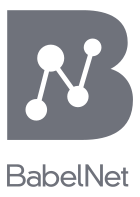BabelNet
 | |
| Stable release |
BabelNet 3.7
/ August 2016 |
|---|---|
| Operating system | |
| Type | |
| License | Attribution-NonCommercial-ShareAlike 3.0 Unported |
| Website |
babelnet |
BabelNet is a multilingual lexicalized semantic network and ontology developed at the Linguistic Computing Laboratory in the Department of Computer Science of the Sapienza University of Rome.[1][2] BabelNet was automatically created by linking Wikipedia, to the most popular computational lexicon of the English language, WordNet. The integration is performed by means of an automatic mapping and by filling in lexical gaps in resource-poor languages with the aid of statistical machine translation. The result is an "encyclopedic dictionary" that provides concepts and named entities lexicalized in many languages and connected with large amounts of semantic relations. Additional lexicalizations and definitions are added by linking to free-license wordnets, OmegaWiki, the English Wiktionary, Wikidata, FrameNet, VerbNet and others. Similarly to WordNet, BabelNet groups words in different languages into sets of synonyms, called Babel synsets. For each Babel synset, BabelNet provides short definitions (called glosses) in many languages harvested from both WordNet and Wikipedia.

Statistics of BabelNet
As of August 2016, BabelNet (version 3.7) covers 271 languages, including all European languages, most Asian languages, and Latin. BabelNet 3.7 contains almost 14 million synsets and about 746 million word senses (regardless of their language). Each Babel synset contains 2 synonyms per language, i.e., word senses, on average. The semantic network includes all the lexico-semantic relations from WordNet (hypernymy and hyponymy, meronymy and holonymy, antonymy and synonymy, etc., totaling around 364,000 relation edges) as well as an underspecified relatedness relation from Wikipedia (totaling around 380 million relation edges).[1] Version 3.7 also associates about 11 million images with Babel synsets and provides a Lemon RDF encoding of the resource,[3] available via a SPARQL endpoint. 2.67 million synsets are assigned domain labels.
Applications
BabelNet has been shown to enable multilingual Natural Language Processing applications. The lexicalized knowledge available in BabelNet has been shown to obtain state-of-the-art results in:
- semantic relatedness[4][5]
- multilingual Word Sense Disambiguation[6]
- multilingual Word Sense Disambiguation and Entity Linking with the Babelfy system[7]
- video games with a purpose[8]
Prizes and acknowledgments
BabelNet received the META prize 2015 for "groundbreaking work in overcoming language barriers through a multilingual lexicalised semantic network and ontology making use of heterogeneous data sources".
BabelNet featured prominently in a TIME magazine's article[9] about the new age of innovative and up-to-date lexical knowledge resources available on the Web. The article describes in some detail how BabelNet is playing a leading role in the 21st century scenario.
See also
- Babelfy
- EuroWordNet
- Knowledge acquisition
- Linguistic Linked Open Data
- OmegaWiki
- Semantic network
- Semantic relatedness
- Wikidata
- Wiktionary
- Word sense disambiguation
- Word sense induction
- UBY
References
- ↑ R. Navigli, S. P. Ponzetto. BabelNet: Building a Very Large Multilingual Semantic Network. Proc. of the 48th Annual Meeting of the Association for Computational Linguistics (ACL 2010), Uppsala, Sweden, July 11–16, 2010, pp. 216–225.
- ↑ M. Ehrmann, F. Cecconi, D. Vannella, J. McCrae, P. Cimiano, R. Navigli. Representing Multilingual Data as Linked Data: the Case of BabelNet 2.0. Proc. of the 9th Language Resources and Evaluation Conference (LREC 2014), Reykjavik, Iceland, 26–31 May 2014.
- ↑ R. Navigli and S. Ponzetto. 2012. BabelRelate! A Joint Multilingual Approach to Computing Semantic Relatedness. Proc. of the 26th AAAI Conference on Artificial Intelligence (AAAI 2012), Toronto, Canada, pp. 108-114.
- ↑ J. Camacho-Collados, M. T. Pilehvar and R. Navigli. NASARI: a Novel Approach to a Semantically-Aware Representation of Items. Proc. of the 2015 Conference of the North American Chapter of the Association for Computational Linguistics (NAACL 2015), Denver, Colorado (US), 31 May-5 June 2015, pp. 567-577.
- ↑ R. Navigli and S. Ponzetto. Joining Forces Pays Off: Multilingual Joint Word Sense Disambiguation. Proc. of the 2012 Conference on Empirical Methods in Natural Language Processing (EMNLP 2012), Jeju, Korea, July 12–14, 2012, pp. 1399-1410.
- ↑ A. Moro, A. Raganato, R. Navigli. Entity Linking meets Word Sense Disambiguation: a Unified Approach. Transactions of the Association for Computational Linguistics (TACL), 2, pp. 231-244, 2014.
- ↑ D. Jurgens, R. Navigli. It's All Fun and Games until Someone Annotates: Video Games with a Purpose for Linguistic Annotation. Transactions of the Association for Computational Linguistics (TACL), 2, pp. 449-464, 2014.
- ↑ Katy Steinmetz. Redefining the modern dictionary, TIME magazine, vol. 187, 23 maggio 2016, pp. 20-21.